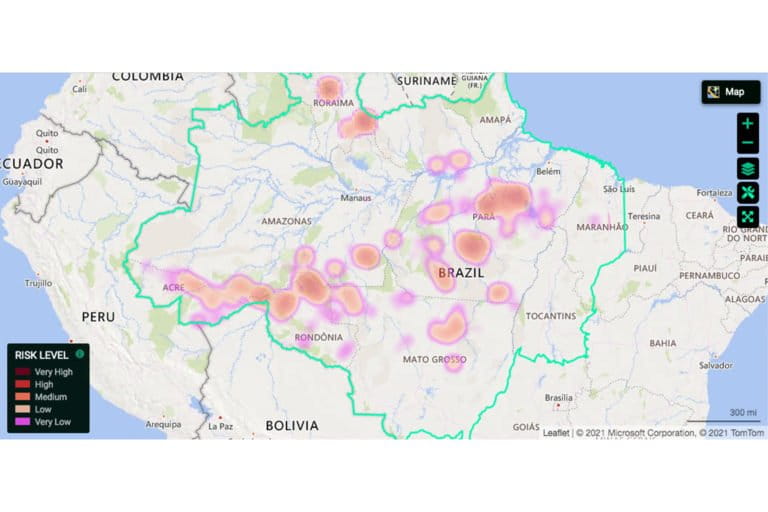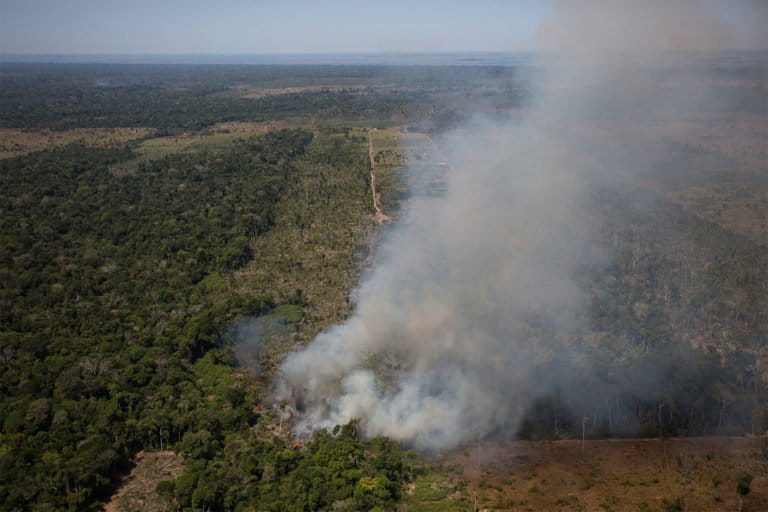- A new tool co-developed by Microsoft using artificial intelligence to predict deforestation hotspots has identified nearly 10,000 square kilometers of the Brazilian Amazon that’s in imminent danger.
- Called PrevisIA, it uses artificial intelligence to analyze satellite imagery from the European Space Agency, and an algorithm developed by the Brazilian conservation nonprofit Imazon to find the areas most prone to deforestation.
- The tool, which the developers say could potentially be applied to any forested area on Earth, will be used for preventive actions, in partnerships with local governments, corporations and nonprofits.
- The next step of the project is to build partnerships with local governments and institutions to act on preventing deforestation, which is the most challenging phase of the project, according to Imazon researcher Carlos Souza Jr.
Nearly 10,000 square kilometers of the Brazilian Amazon, an area the size of Lebanon, is at high risk of being cleared, according to a new tool using artificial intelligence technology to help forecast deforestation before it actually happens.
Named PrevisIA (from the Portuguese previsão for “forecast” and IA for “artificial intelligence”), the tool analyzes images provided by European Space Agency satellites, and through an algorithm created by the Brazilian conservation nonprofit Imazon, finds areas prone to deforestation.
Imazon studies published in scientific journals show that 95% of accumulated deforestation in the Amazon is located within a 5.5-kilometer (3.4-mile) radius of roads; 90% of annual fires occur 4 km (2.5 mi) from illegal roads built in the middle of the forest for logging, mining and land grabbing.

In 2006, the non-profit started to monitor satellite images manually to find these roads before the area around them was cleared of trees, but the laborious and time-consuming work prevented it from scaling up — a problem that the new technology aims to solve. The tool mapped so far the Brazilian Amazon, but could potentially be expanded to any forested area on Earth, the developers say.
The first report using the new tool launched last week shows that 192 municipalities have a high or very high risk of deforestation in Brazil’s portion of the Amazon. Additionally, 48 Indigenous reserves have the same level of risk, as well as 18 conservation units. Also at high and very high risk of deforestation are two quilombos, communities of the Afro-Brazilian descendants of runaway slaves, and 789 rural settlements. In total, this comprises 9,635 km2 (3,720 mi2) of threatened forest.
The next step of the project, developed jointly by Imazon, U.S. technology giant Microsoft and Brazilian mining company Vale, is to build partnerships with local governments and institutions to act on preventing deforestation, which is the most challenging phase of the project, according to Imazon researcher Carlos Souza Jr.
There are two main strategies: one involves civil society organizations and corporations; and the other, governmental institutions, Souza Jr. said. The private sector will act in a “positive intervention,” he said, an approach that includes providing municipalities with information technology to make progress on environmental management.

“We want them to attract the financial sector with differentiated credit lines for those capable of actually reducing deforestation. There are many market initiatives that could work there, such as carbon credits, investments in forestry, having protocols to actually quantify avoided [greenhouse gas] emissions,” he told Mongabay in a phone interview.
When it comes to the governments’ role, Imazon is betting on municipalities and state governments to take the lead, Souza Jr. said, since there are no open lines of communication with the federal government, which has often been criticized for its anti-environment stance.
“The states have the opportunity to become environmental protagonists. Deforestation does not bring any advantages, even financially; buyers of agricultural products are starting to boycott Brazil due to deforestation. People need to understand that it is actually more profitable to have the forest standing,” Souza Jr. said, adding that local prosecutors’ offices are also becoming allies in tackling deforestation.
He also said partnerships with corporations have great potential to boost environmental conservation, noting that the launch of the technology platform already demonstrated a difference in the participation of private parties, with companies actually using their expertise to help build the project instead of just donating money to nonprofits.

Rodrigo Kede Lima, Microsoft’s president for Latin America, said he believes PrevisIA is today one of the most important projects for environmental preservation. “Through intelligent algorithms in the cloud we are able to forecast deforestation and forest fires before they happen. This is one of the biggest examples that technology can help build a better world,” he said at the launch of the platform on Aug. 4.
“The planet is in a hurry, so should we [be],” Tania Consentino, president of Microsoft Brazil, said at the same online event. “The solution for the environmental issues require a coordinated action, not only from the government but together with corporations, nonprofits and society as [a] whole.”
Vale, Brazil’s biggest miner and a frequent target of criticism for its role in some of the worst environmental and social disasters in the country, joined the initiative because “protecting the Amazon is strategic,” according to Hugo Barreto, the company’s director of investments and social development. Speaking at the launch event, he said Vale today directly protects more than 10,000 km2 (3,860 mi2) of forest in the Amazon, and will increase this number by another 5,000 km2 (1,930 mi2).
Banner image: Deforestation in Parecis in the state of Rondonia, Brazil. Image by Rhett A. Butler/Mongabay.
Editor’s note: This story was supported by XPRIZE Rainforest as part of their five-year competition to enhance understanding of the rainforest ecosystem. In respect to Mongabay’s policy on editorial independence, XPRIZE Rainforest does not have any right to assign, review, or edit any content published with their support.
FEEDBACK: Use this form to send a message to the author of this post. If you want to post a public comment, you can do that at the bottom of the page.














